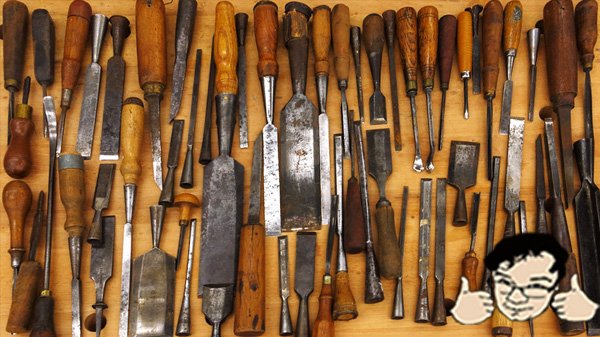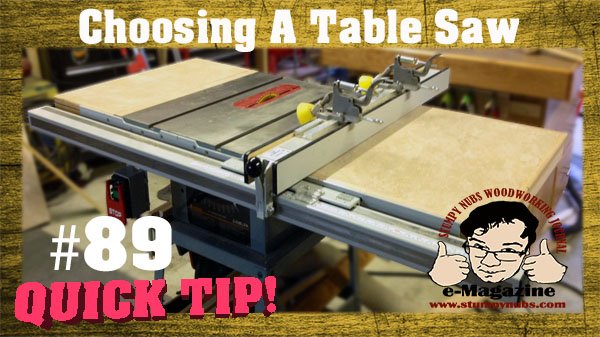
WHY A LOT OF TOOL STEEL IS BAD
At some point, every woodworker is confronted with the argument that old tools—particularly chisels—are superior to new ones. It's not uncommon for some to pay more for an antique chisel than for a new, high-quality one. But is it true? Are these old tools, made in an era when quality was prioritized over cost, truly better than most modern chisels?

A CLEVER WAY TO MAKE INDESTRUCTIBLE BOXES, CABINETS, AND DRAWERS
Imagine you're assembling a big cabinet, and you're trying to get the clamps in place without everything sliding out of alignment at the corners because the glue is slippery. The locking nature of these corners eliminates that problem and makes project assembly a breeze… Almost as strong as dovetails, but way easier to make.

WHY I DON’T USE GORILLA GLUE
Years ago, I used to think white glue was for paper, yellow glue was for woodworking, and that was all there was to it. But with time and experience, I’ve learned that there exists a wide range of glues that are useful for woodworkers. Choosing the right one for your project can be a real game-changer. You can solve some really frustrating problems if you know a little bit about glue. So, in this article, I will pass along what I know so you can reap the benefits of glue technology in your workshop.

THE ONLY 3 BANDSAW BLADES YOU NEED
When was the last time you had to buy a bandsaw blade? It was confusing, wasn’t it? Different types of metal, varying tooth counts, and geometry—these are not meaningless choices. Choosing the right blade can make a big difference in how your next project turns out!

HOW TO READ A TAPE MEASURE WITHOUT LOOKING LIKE AN IDIOT
Believe it or not, the first question on some job interviews in industrial trades is, “Can you read a measuring tape?” That may sound silly to a lot of you old-timers, but you'd be surprised how many younger folks never make it past that first question because they have no idea what they're doing with this simple tool. So, in this post, I’m going to share with you how to teach a poor, ignorant kid in your life.

WORLD’S STRONGEST CORNER JOINT!
I love interesting joinery. The right joint can be incredibly strong, but it can also be beautiful in and of itself. I think this joint is a perfect example. I call it the Triple-Castle Joint. If I were a gamer, I might call it the Tri-Force Joint. I have no idea who first came up with it, but I love the complexity—at least the perceived complexity. While this joint looks like a puzzle of mortises and tenons that would be frustratingly difficult to cut, it’s actually made from…

THE FORGOTTEN STORY BEHIND JAPANESE CHISELS
While Japanese chisels as woodworking implements have existed for centuries, it was the makers of the famed samurai swords that may have given us the chisels OF today. In this post, I'll share that forgotten story and help decode the fascinating technology that makes Japanese woodworking chisels so different from modern Western-style chisels. By the end, you'll have a whole new respect for this strange little tool with the dented backside.

HOW TO BEND 3/4” PLYWOOD
In this post, I’ll share the lessons we learned along the way, including how to bend plywood, edge band around a curve, and a few other skills you might want to apply to a future project of your own.

THE HISTORY OF SANDPAPER
Every time I talk about sandpaper, someone tries to shame me for not using hand planes and scrapers to smooth every surface like a “real” woodworker. They are under the false impression that sandpaper is a modern invention, which the great masters of the past would never have touched.

THE TRUTH ABOUT HOLLOW GRINDS: DO THEY REALLY WEAKEN YOUR EDGE?
Millions of people sharpen their tools by grinding them on a round wheel. This isn't a new idea; grinding wheels have been used for centuries. However, as often happens on the internet, it has become trendy to overanalyze and pick apart long-held beliefs, claiming that everyone has been doing it wrong. I’ve heard many people argue that an edge sharpened on a grinding wheel will become brittle or dull more quickly than one sharpened on a flat stone.

HOW SIMPLE WOOD SCREWS ARE NO LONGER THE SAME
Are the higher-priced construction screws such as GRK and Spax worth the cost if you aren’t building something structural, such as framing a house or a deck? Do the fancy features of these screws—such as fluted points, serrated teeth, and complex head geometry—make any difference at all for most day-to-day projects?

WILL A CHEAP 2X6 PINE WORKBENCH LAST?
It’s been 8 years since I made this workbench in a two-part series on YouTube. In that time, this bench has seen a lot of use across three different workshops. Since it's made entirely from old construction lumber I thought some of you might be interested to see how it’s held up and if there’s anything I would change in its design.

THE CLEVER 10-SECOND WOODWORKING TRICK I USE TO IMPRESS PEOPLE
In this post, I'll share with you a clever method to make two pieces of wood fit together in such a satisfying way that you'll start looking all over for scraps to use. Honestly, this technique will make you feel like a woodworking master.

CHOOSING A TABLE SAW
I’m often asked for advice on choosing the right table saw. It seems that a lot of new woodworkers looking for their first saw — and even experienced woodworkers looking to replace their existing saws — are making poor decisions when it comes to choosing the right type with the right features at the right price. As someone who has tried just about every kind of saw out there, I feel like I can help you make the right decision.

JOINTER VS PLANER VS SANDER - WHERE SHOULD YOU START?
When I first started woodworking, there was no way I could afford a jointer and a planer, let alone a drum sander. I knew that each of those machines would be useful, but since I had little experience with any of them, I had no idea which one to buy first, which to get next, or if I even needed all three of them at all…. Let’s take a few minutes to sort this out.

BREAKING: THE USA IS SWITCHING TO METRIC!
I do think it's a little ironic that so many of their arguments center around calling a nation of 350 million people arrogant while presuming to tell them what markings should be on their rulers, from the other side of the planet. And I've poked a little fun at that in the past. But truthfully, I can see how people who don’t understand how fractions work may be afraid of a combination square with strange markings on it.

THE SECRET TO SILKY SMOOTH FINISHES
After spending so much time on a project, pouring your heart, soul, and even your wallet into it, the last thing you want is for someone’s first impression to be spoiled by a rough, bumpy finish. You want those surfaces to be silky-smooth. And that means knowing how to properly sand your project, including between coats of finish.

THE TRUTH ABOUT MDF WILL MAKE YOU THINK TWICE!
Don’t get me wrong, I love beautifully figured, natural wood. I use solid wood in most of my projects. But if you set aside your preconceived notions about manufactured materials, you will find that there is a time and place for MDF, even in fine furniture making.

DUST COLLECTION DUCT WORK: WHY SIZE MATTERS
In this article, I want to offer a simple, easy-to-understand explanation of this small part of a larger subject—specifically why the size of your dust collection hoses and ducts does matter, and why what's right for your shop may not be what you think.

THE THIN KERF DEBATE: A WOODWORKER’S PERSPECTIVE
Nowadays, like anything else, people love to argue about the pros and cons of blade thicknesses. And there’s a lot of misinformation out there—whether you should even be using thin kerf blades, and whether the wrong blade choice can make your table saw more dangerous.
